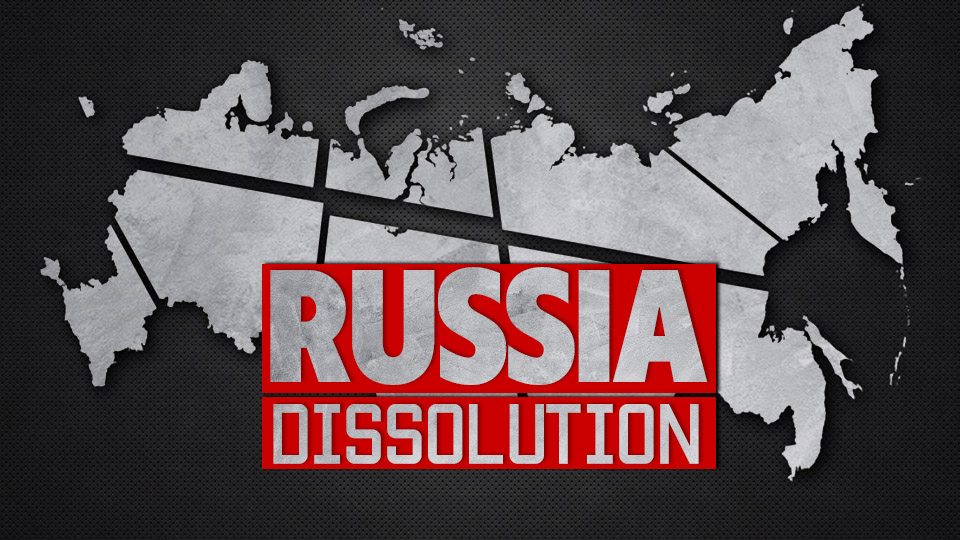
In 2020, there have been several notable developments, that all seem to have been happening along Russia’s borders and in key regions developments in which influencing the Russian position on the international scene.
These include:
- Ukraine’s refusal to seek peace in its East with the Donetsk and Luhansk People’s Republics, and various questionable policies.
- Western-backed protests against Belarusian President Alexander Lukashenko, with a ‘school teacher-turned-politician’ challenging him with an insignificant share of the vote in the presidential election. She received wide support from the West, especially from heavily US-aligned states such as Poland and the Baltics.
- The Syrian Democratic Forces (SDF) and other groups in Syria are being supported openly, and not so openly, by the United States and sabotage the further diplomatic settlement of the conflict in Syria.
- The situation in Central Asia is rather exacerbated, with an evident increase in ISIS activity in Afghanistan, alongside various terrorist elements appearing near its borders with Collective Security Treaty Organization (CSTO) countries. The Russian Security Service – FSB – is hard at work in countering various ISIS and other terror cells on the territory of the Russian Federation, and reports such as these are frequent, meaning that there appears to be a network that is successful in either moving terrorist elements into the country, or recruiting them there.
- There also was the Armenian-Azerbaijan War in Nagorno-Karabakh, which Russia didn’t directly involve itself in, since the fight was for the self-proclaimed independent republic of Artsakh, and Armenia never officially asked for assistance. Regardless, with the Peace Deal it brokered on November 10th, there have been numerous voices in Armenia blaming Russia for the defeat. And that is even though it essentially saved it from an even bigger fiasco and loss of territory. At the same time, despite being the victor, Azerbaijan simply received what it was promised with the Minsk agreements, with the addition of Shusha. There are protests against Russia in Azerbaijan, a country in which any non-government sanctioned protest is snuffed, violently. There are calls that Russia stole the “glorious victory”, while in Armenia there are calls to renew hostilities, while the Russian peacekeepers are there and somehow force their hand in the fight.
- Turkey deployed thousands of Syrian militants to South Caucasus, and there are claims that it is even reportedly attempting to relocate families from Syria’s Afrin and other areas to the parts of Karabakh that were given to Azerbaijan. This is likely to also provide a fresh extremist presence in the region.
- Turkey, once again, appeared to be shifting its gaze towards Crimea, but also cooperate with Ukraine in terms of selling UAVs to it and other military equipment.
All of these developments, somehow, almost entirely coincide with a report which the RAND Corporation released back in 2019.
The report is called “Extending Russia” with the subtitle “Competing from Advantageous Ground.” A short description of the report reads the following:
“The steps we posit would not have either defense or deterrence as their prime purpose, although they might contribute to both. Rather, these steps are conceived of as measures that would lead Russia to compete in domains or regions where the United States has a competitive advantage, causing Russia to overextend itself militarily or economically or causing the regime to lose domestic and/or international prestige and influence. This report deliberately covers a wide range of military, economic, and political policy options. Its recommendations are directly relevant to everything from military modernization and force posture to economic sanctions and diplomacy; consequently, it speaks to all the military services, other parts of U.S. government that have a hand in foreign policy, and the broader foreign and defense policy audience.”
Notably, the report suggests that the following “Geopolitical measures” need to be employed in order to counter Russia’s spreading influence and capabilities to provide an adequate answer to an extraordinary situation.
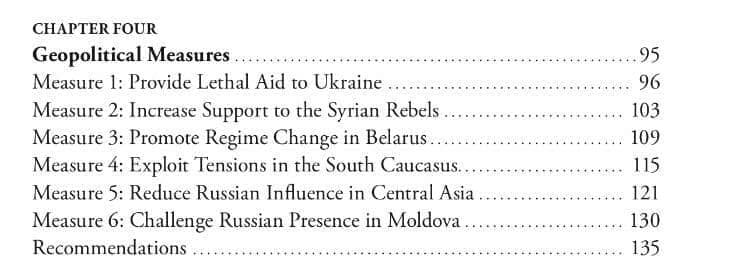
This chapter describes six possible U.S. moves in the current geopolitical competition:
- providing lethal arms to Ukraine,
- resuming support to the Syrian rebels,
- promoting regime change in Belarus,
- exploiting Armenian and Azeri tensions,
- intensifying attention to Central Asia,
- isolating Transnistria (a Russian-occupied enclave within Moldova).
There are several other possible geopolitical moves discussed in other RAND research but not directly evaluated here—including intensifying NATO’s relationship with Sweden and Finland, pressuring Russia’s position in the Arctic, and checking Russia’s attempts to secure its influence in Asia.
Ukraine
Between 2014 and 2016, the US provided $600 million in security assistance to Ukraine. These funds have been used to train Ukrainian military forces and provided nonlethal military equipment, including counterartillery and countermortar radars, secure communications, logistics systems, tactical unmanned reconnaissance aircraft, and medical equipment.
According to RAND, the US could increase its military assistance to Ukraine, or increase its calls to allow Kiev into NATO.
“Expanding U.S. assistance to Ukraine, including lethal military assistance, would likely increase the costs to Russia, in both blood and treasure, of holding the Donbass region. More Russian aid to the
separatists and an additional Russian troop presence would likely be required, leading to larger expenditures, equipment losses, and Russian casualties. The latter could become quite controversial at home, as it did when the Soviets invaded Afghanistan.”
Eastern Ukraine is already a significant drain on Russian resources, exacerbated by the accompanying Western sanctions. Increasing U.S. military aid would certainly drive up the Russian costs, but doing so could also increase the loss of Ukrainian lives and territory or result in a disadvantageous peace settlement. This would generally be seen as a serious setback for U.S. policy.
What’s going on in reality? There appears to be no conclusive peace settlement in Ukraine, and anti-Russian policy continues moving forward full speed. The Kiev regime, at large controlled from Washington, is intentionally sabotaging attempts to de-escalate the situation and publicly preparing for a new military operation in eastern Ukraine. Recently, pro-Kiev sources started laying great hopes on the Turkish military aid. For sure, the US is also involved. In August 2020, incoming US President Joe Biden promised to provide Ukraine with even more lethal weapons. In late 2019, the Trump administration also approved several sales of “defensive lethal weapons” to Ukraine.
As such this part of RAND’s suggestion appears to be moving, more or less, according to plan.
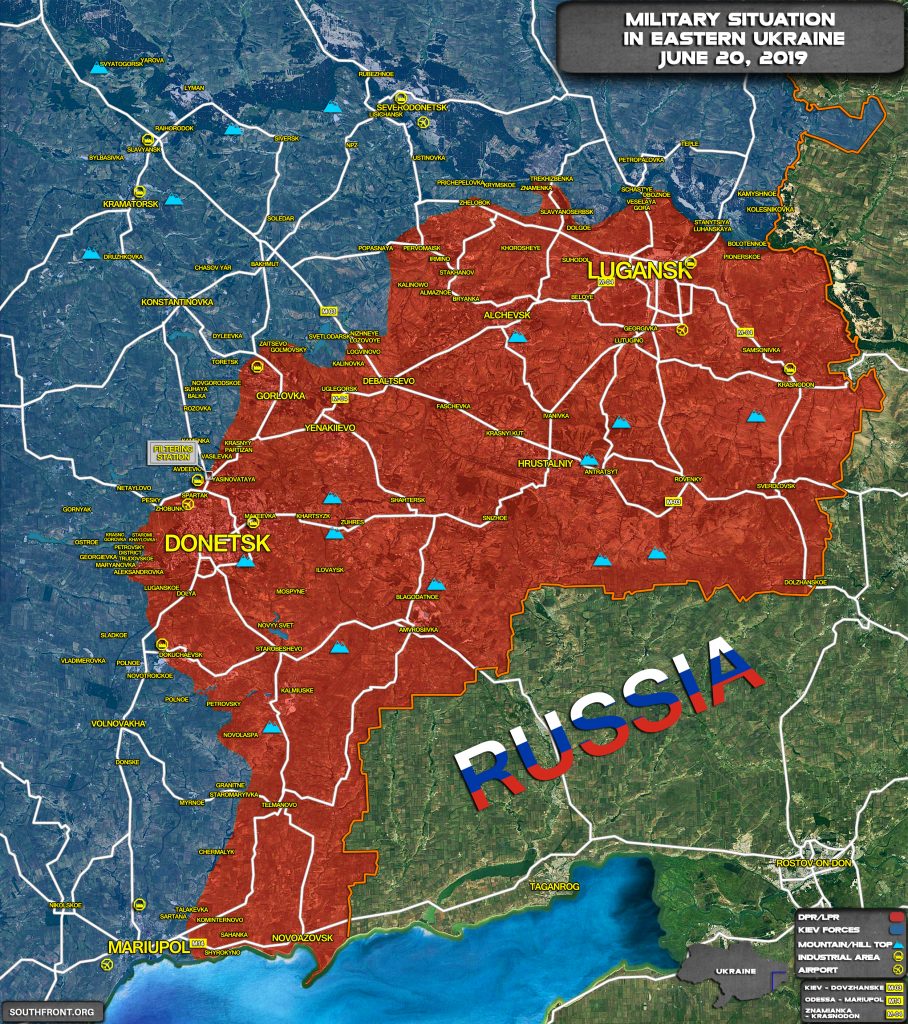
Syria
“In 2015, Russia’s intervention in Syria cost an estimated $2.4 million to $4 million a day, according to the Moscow Times and IHS Janes’ estimates. 34 Given the size of Russia’s defense budget ($50 billion that year), the sum might not be significant in and of itself.”
Increased U.S. support to the so-called ‘moderate’ Syrian opposition could perpetuate and intensify a civil war that had begun to wind down, thereby imposing attritional costs on both Russia and Iran.
RAND believes that such support should also reduce the “moderate opposition’s” reliance on the better-armed, more extremist groups and ultimately might improve the willingness and ability of moderate opposition forces to combat the “more extremist elements.” Now, first of all RAND doesn’t even deny that the most of “moderate opposition” is made up of extremists, who are fighting against even more extreme elements.
At the same time, the reality of the situation is this: the US, with all its claims of complete withdrawal from Syria, simply employed the SDF separatist leadership as a tool of sabotaging the peace settlement in Syria, while Washington is looting Syria’s oil fields. US companies exploit Syrian oil resources. Some of the money is used to bankroll the SDF.
The Russian side has repeatedly also claimed that ISIS and ISIS-affiliated fighters were being trained and received improved weaponry in the US-controlled areas of Syria.
Unlike Ukraine, the United States does not have a single actor to aid in the fight in Syria but rather faces a plethora of groups—often with murky affiliations—increasing the chances of weapons falling into the wrong hands.
“Supporting the rebels could run counter to the most prominent objective of the Trump administration’s Middle East foreign policy—fighting radical Islamist terrorism.”
In the highly unlikely event of total success—if Russia were to abandon the Assad government and the opposition were to somehow ‘defeat’ Damascus—the result would be a major geopolitical setback for Moscow but also a major contraction in its foreign commitments and associated expenditures, not to mention a huge responsibility for the United States and its allies to assume.
At the same time, it appears that supporting the “moderate rebels” isn’t proving effective enough and Israel is picking up the slack with targeting various Syrian and alleged Iranian positions in the areas under Damascus’ control.
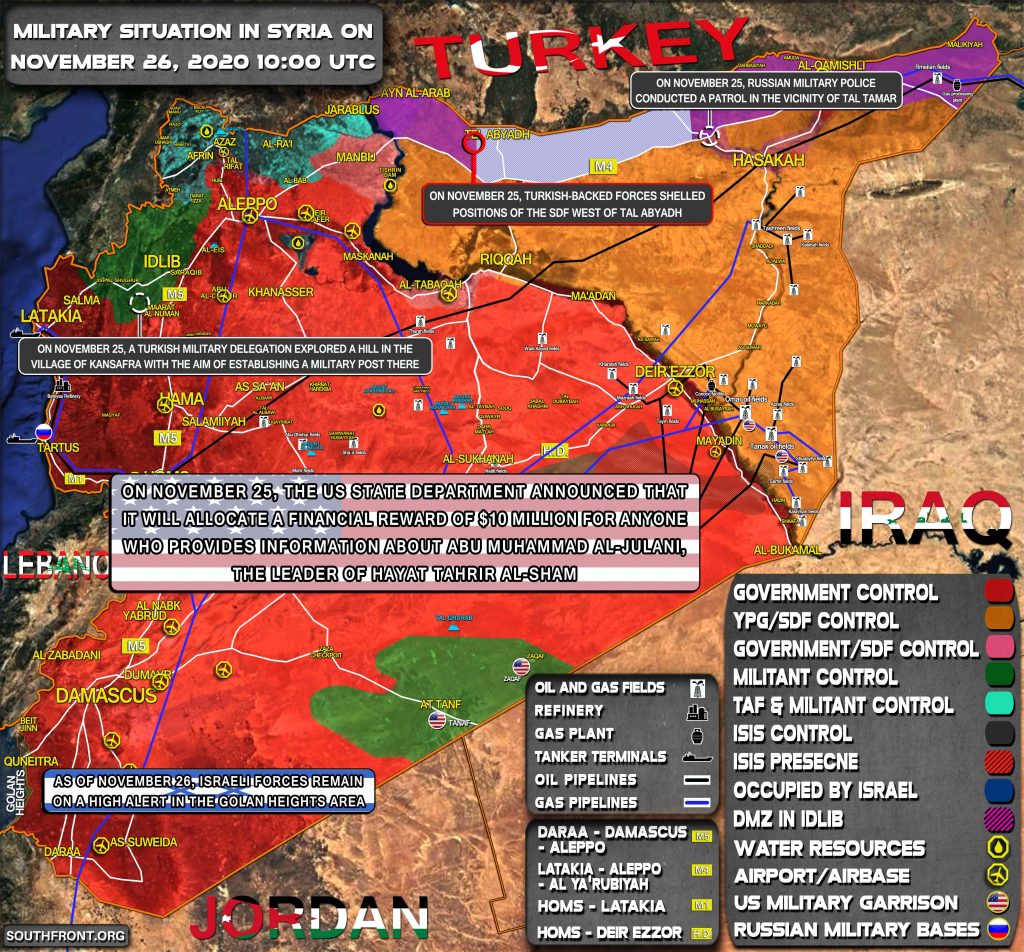
Essentially, there were some attempts, but none of them are any significant, since the fight in Syria appears to be too far gone.
Likewise, according to RAND, this course of action might have been viable a few years ago, when the armed opposition was stronger and less radicalized. Under current circumstances, the most that expanded U.S. aid could likely do would be to perpetuate a conflict that has already destabilized an entire region. Russia might be forced to pay a bit more for its Syrian commitment but only at the cost of continued regional turbulence, societal radicalization, and increased civilian casualties and displaced personnel.
Belarus
Belarus is Russia’s neighbour and important ally. It provides a buffer between Russia and major NATO countries and is the initial link in Russia’s ground lines of communication between the mainland and Kaliningrad— the Russian enclave entirely encircled by Lithuania and Poland. Already host to Russian forces, Belarus features prominently in many notional conflicts among the United States, NATO, and Russia.
In a zero-sum world, denying Russia its one and only true ally would be a clear geopolitical and ideological gain for the West. It would bring an end to “Europe’s last dictatorship,” a long-standing U.S. policy goal.
“Starting revolutions is not easy, and the United States lending public support to opposition movements does not guarantee that they will be successful. In 2007, Gallup found that 60 percent of Belarusian respondents believed democracy was important and 47 percent believed it was “somewhat” or “very” important for Belarus to have an active opposition party.”
RAND considered regime change in Belarus as one of the most significant escalations, but the attempts have all but failed, and with Russia actually not having to lift a finger.
Even despite Lukashenko attempt to get some concessions from Russia prior to the protests in the country.
“Promoting regime change in Belarus is one of the most escalatory options considered in this report. Such an effort probably would not succeed and could provoke a strong Russian response, including the possibility of military action. Such a reaction might extend Russia by requiring the nation to commit resources to preserve its grasp over Belarus, thereby provoking the United States and its European allies to respond with harsher sanctions, but the result would be a general deterioration of the security environment in Europe and a setback for U.S. policy.”
Currently, protests in Belarus are still on-going, but they’ve barely achieved any real progress in the regime change agenda. However, the Western/NATO interference in the internal situation in Belarus is an undeniable fact.
Lukashenko may be making some interesting claims regarding Russia, or attempting to play tough in order to get a discount from Moscow on natural gas, or some other commodity, but at the same time is wise enough to continue actively communicating with Russian President Vladimir Putin and remain a formal ally.
Nagorno-Karabah: Armenia and Azerbaijan
The RAND analysis begins with reminding that in 2008, the Georgian-Russian relations with damaged severely, after a few days of war and the resulting South Ossetia and Abkhazia as separate countries.
Russia also plays a key role with Azerbaijan and Armenia, particularly over the disputed territory of Nagorno-Karabakh. Ethnically Armenian but geographically located within Azerbaijan, Nagorno- Karabakh’s bid to join the Armenia Soviet Socialist Republic during the latter years of the Soviet Union was denied by the Soviet Politburo because of the risk of encouraging secessionist movements elsewhere.
According to RAND, the United States could extend Russia in the Caucasus in two ways. First, the United States could push for a closer NATO relationship with Georgia and Azerbaijan, likely leading Russia to strengthen its military presence in South Ossetia, Abkhazia, Armenia, and southern Russia.
Alternatively, the United States could try to induce Armenia to break with Russia.
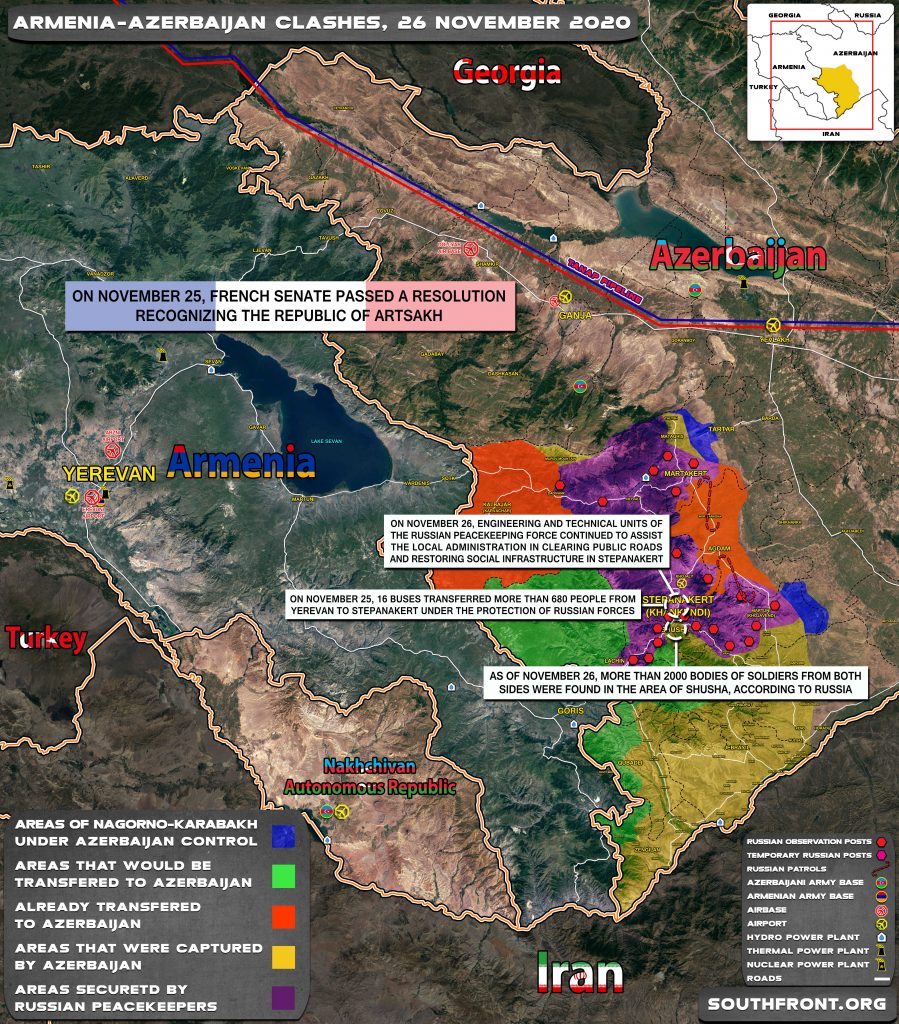
“Increased U.S. involvement in the region could produce additional economic benefits as well. The Caspian Sea remains a key producer of both oil and natural gas. Indeed, the U.S. Department of Energy estimates that there are “48 billion barrels of oil and 292 trillion cubic feet of natural gas in proved and probable reserves in the Caspian basins. Almost 75 percent of oil reserves and 67 percent of natural gas reserves are located within 100 miles of the coast.”
According to the analysis, resolving Nagorno-Karabakh is likely a prerequisite to Armenia breaking with Russia, but it is unclear precisely how the United States or NATO could resolve the decades-old conflict without privileging one side and antagonizing the other. NATO has encouraged both parties to resolve the conflict through the Minsk Group—led by the Russians.
Currently, the situation in Nagorno-Karabakh and the six-week war that started on September 27th, 2020 was due to several factors.
Notably, Armenian Prime Minister Nikol Pashinyan, as an avid supporter of the West worked to the benefit of what RAND describes and distanced Armenia from Russia with questionable policy.
In turn, Turkey, in support of Azerbaijan saw a chance, prepared and began to largely pull the strings on Baku’s offensive on the region.
Still, Russia managed to somehow salvage the situation for Yerevan, by brokering a peace deal which saw Azerbaijan get what it was supposed to be given under the Minsk Agreements, with the addition of Shusha.
Pashinyan, however, continued blaming Russia, the Armenian population, foreign countries and such for the failure and the gross mismanagement of Armenia’s forces in the war.
Azerbaijan’s president Ilham Aliyev presents the war as “gloriously won” but there are some elements which are protesting and claiming that Moscow actually robbed Baku of its “glorious victory.”
There are anti-Russian protests, in a country in which all non-government approved protests are violently stopped.
The US made some claims for peace and so on, as did many Western countries, with France even attempting to somehow mediate the conflict, but only barely.
Paris attempted to prove itself as a valuable ally to Armenia, but in the end, it simply said “we are with you, our Armenian brothers” and all they provided were empty words.
In Armenia, in order for Pashinyan and the pro-Western leadership to remain, political arrests of the opposition began. As such, support for Russia still remains rather low, and it is playing to the measure that RAND outlined in April 2019. In the current conditions, pro-Western forces in the region would continue their efforts to destabilize the region creating chaos near the Russian border and setting conditions for the NATO expansion there.
Central Asia
Russia is part of two economic ventures related to Central Asia: the Eurasian Economic Union and the Belt and Road Initiative. Russia has benefited from both, although in the case of the former, partners might have been harmed economically. There might be steps the United States and allies could take to reduce Russia’s benefits from both of these.
Engaging more with Central Asia could have modest benefits. Expanding Central Asian connectivity to the rest of the world could reduce that area’s trade with Russia. It must be noted, however, that economic growth within these countries would likely have the opposite effect and increase their trade with Russia because economic size and trade are correlated.
Now, little of this has succeeded in the year. Notably, and not in the vein which RAND describes is that militant activity in Afghanistan, as well as along its borders with the CSTO countries has increased, which Russia sees as a threat.
There are frequent reports of the FSB arresting various terrorist elements that either came from Central Asian republics or were recruited from groups from there. There is little evidence that the US has anything to do with that, but there are some reports that unknown black hawks have been extracting militants from all around, and they’ve resurfaced in northern Afghanistan, after a while.
The US efforts to counter China’s Belt and Road Initiative, and is attempting to counter various projects in the Eurasian Economic Union, which Russia is part of such as the Nord Stream 2, but they are unrelated to Central Asia. In conclusion, regarding this, RAND appears to be a bit far from what’s been carried out, or if such measures are being implemented – they’re not being effective.
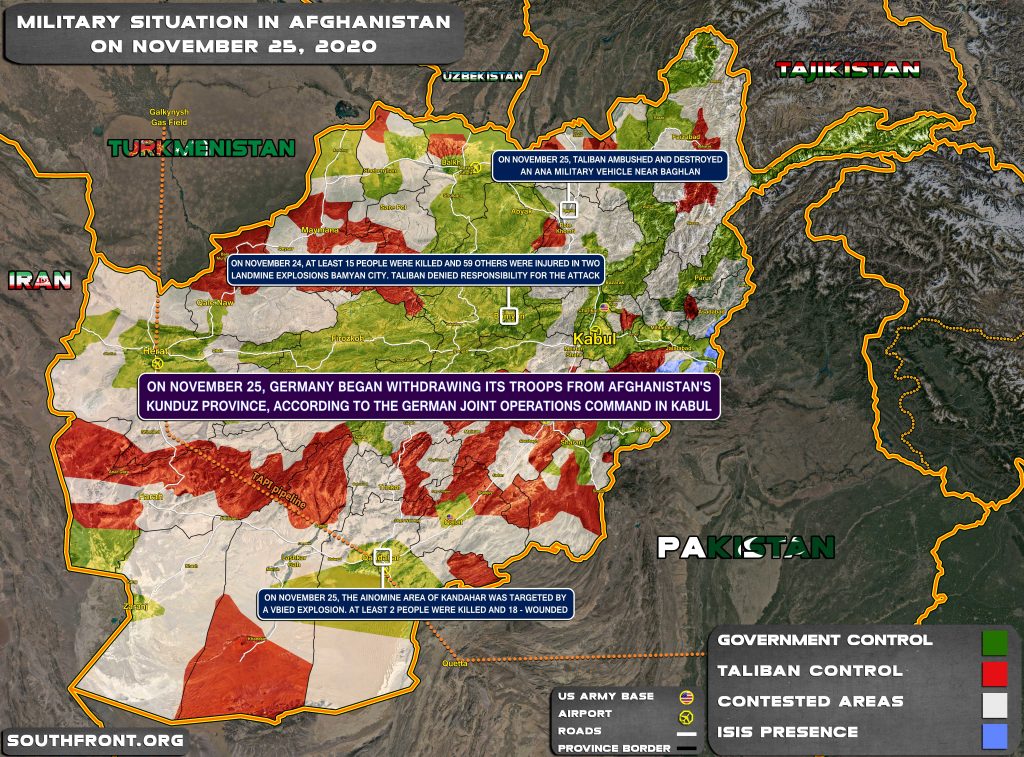
Moldova
Transnistria is a Russian-speaking enclave within Moldova that currently hosts a Russian peacekeeping force and army base.
Officially, Russian policy toward Transnistria is ambiguous. Russia’s Foreign Policy Concept includes only a single, rather inarticulate statement:
Russia strongly advocates a political and diplomatic settlement of conflicts in the post-Soviet space, specifically, Russia works within the existing multilateral negotiating mechanism to find an inclusive solution to the Transnistrian issue, respecting the sovereignty, territorial integrity and neutral status of the Republic of Moldova in determining the special status of Transnistria.
The United States could encourage Transnistria’s youth (who, according to some journalistic accounts, might be more pro-West than their elders) to push their pseudo-state to leave the Russian orbit.
Moldovan cooperation in an effort to expel the Russians would not be easy to secure. In an interview with Radio Free Europe/Radio Liberty, Moldova’s pro-Russian President Igor Dodon stated, “A NATO office in Chisinau [Moldova’s capital], in a neutral country, is a provocation. I do not want this. I want neither NATO nor this Russia-led [military] alliance as far as armed forces are concerned.”
There’s been very limited movement throughout 2020, but it is likely that activities have been more focused on Belarus, Ukraine and Nagorno-Karabakh, and Moldova has been left for sometime in the near (or far future). The pro-Western presidential candidate, Maia Sandu, won the 2020 election in Moldova, and she’s already promoting the ideal of the need of the withdrawal of the Russian peacekeeping force from Transnistria. This move sets conditions for the increase of instability.
RAND’s General Recommendations
Extending Russia through geopolitical competition is a fundamentally difficult and dangerous proposition. One might bait Russia into extending its foreign commitments, but only at the risk of serious setbacks to local U.S. partners. Even if such efforts succeeded in generating Russian withdrawals, the result would be the opposite of an extension.
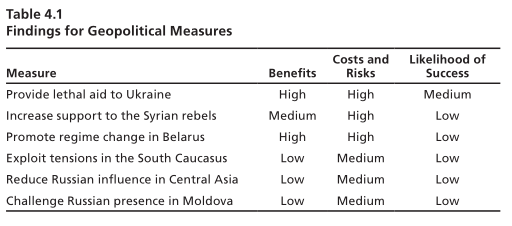
Any geopolitical moves to extend Russia would also need to consider other options that (for reasons of length and resources) were not considered here in depth—namely, intensifying NATO’s cooperation with Sweden and Finland, pressuring Russia’s claims in the Arctic, and checking its influence in the Arctic.
Many of these are not exactly spot on, and whether they’re entirely connected to what’s going on comes down to conspiracy theories. However, it is fact that within a year and a half of the publishing, many of these recommendations have been implemented.
There has been a regime change attempt in Belarus, which is still on-going. Armenia and Azerbaijan went to warn for Nagorno-Karabakh, and Russia had to mediate, deploy peacekeepers and further resources, as well as is being accused of both sides for either losing the war for Armenia, or stealing away a bigger victory for Azerbaijan.
Militants are being delivered to South Caucasus, and even families are being relocated there from Syria.
The US and the “moderate rebels” in Syria are still operating, albeit not as actively as before, but Israel is there to provide assistance by bombing Syrian and alleged Iranian targets.
Attempts to spread chaos in Central Asia are apparent, and the FSB continues arresting various extremist elements, but there are likely more who are roaming around and entering the country through various channels.
It is unknown what will happen in Moldova, as of yet, but the trend is alredy seen.
Another thing that could be added is cooperating with Ecumenical Patriarch Bartholomew of Constantinople, assisting in the forming of the autonomous Orthodox Church of Ukraine, making pushes to repeat that questionable “success” in other countries such as Montenegro, and more.
Regardless, pressure on Moscow is being exerted from quite a few directions, at the same time, and it is unlikely that under US President Joe Biden this will end. After all, his chosen aides all plan to improve relations with allies, while countering Russia’s spreading influence. Namely in Ukraine, since Biden appears to have a soft spot for the country from which he and his son allegedly funneled billions. Ukraine, and Eastern Ukraine, could also be the best direction from which to target Russia.
Things are still developing on many fronts, and the pieces are yet to fall squarely on the board.
MORE ON THE TOPIC:
Filed under: Armenia, Iran, NATO, Poland, Russia, Syria, Turkey, Ukraine, USA | Tagged: Azerbaijan, brl, Central Asia, Crimea, CSTO, Karabakh, Minsk Agreements, Moderate Terrorist, Moldova, RAND Corporation, SDF, Syrian mercenaries |
Related posts:
Views: 0
 RSS Feed
RSS Feed

















 December 1st, 2020
December 1st, 2020  Awake Goy
Awake Goy 



 Posted in
Posted in  Tags:
Tags: 
















